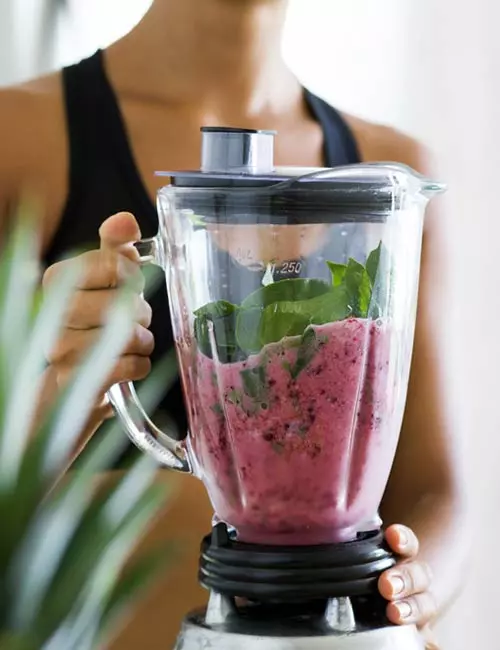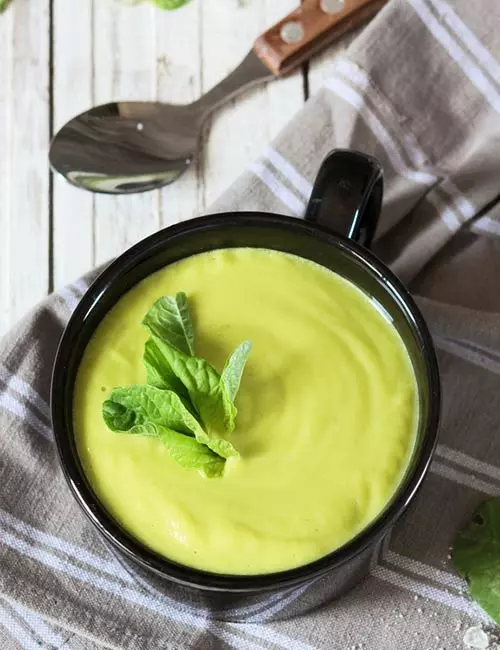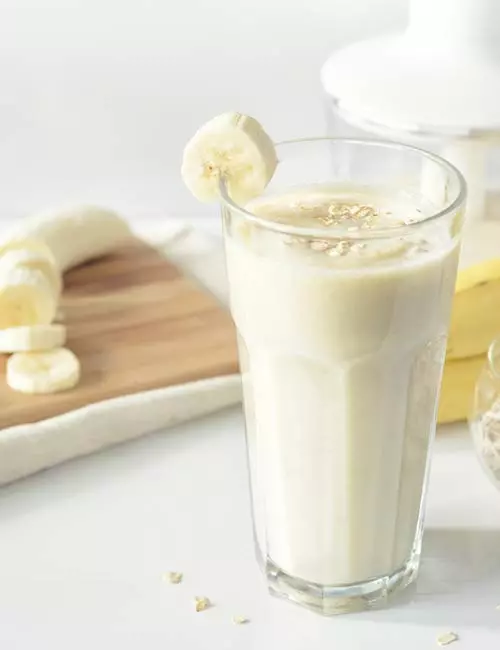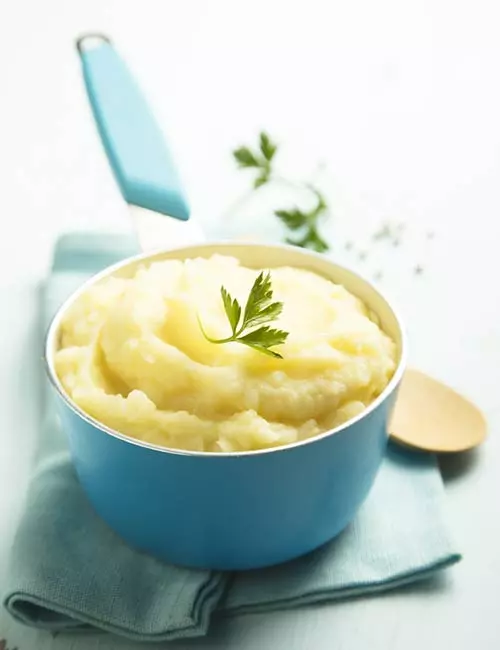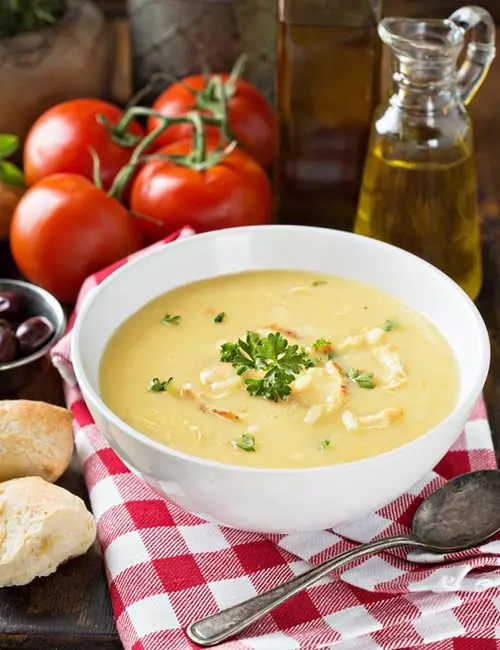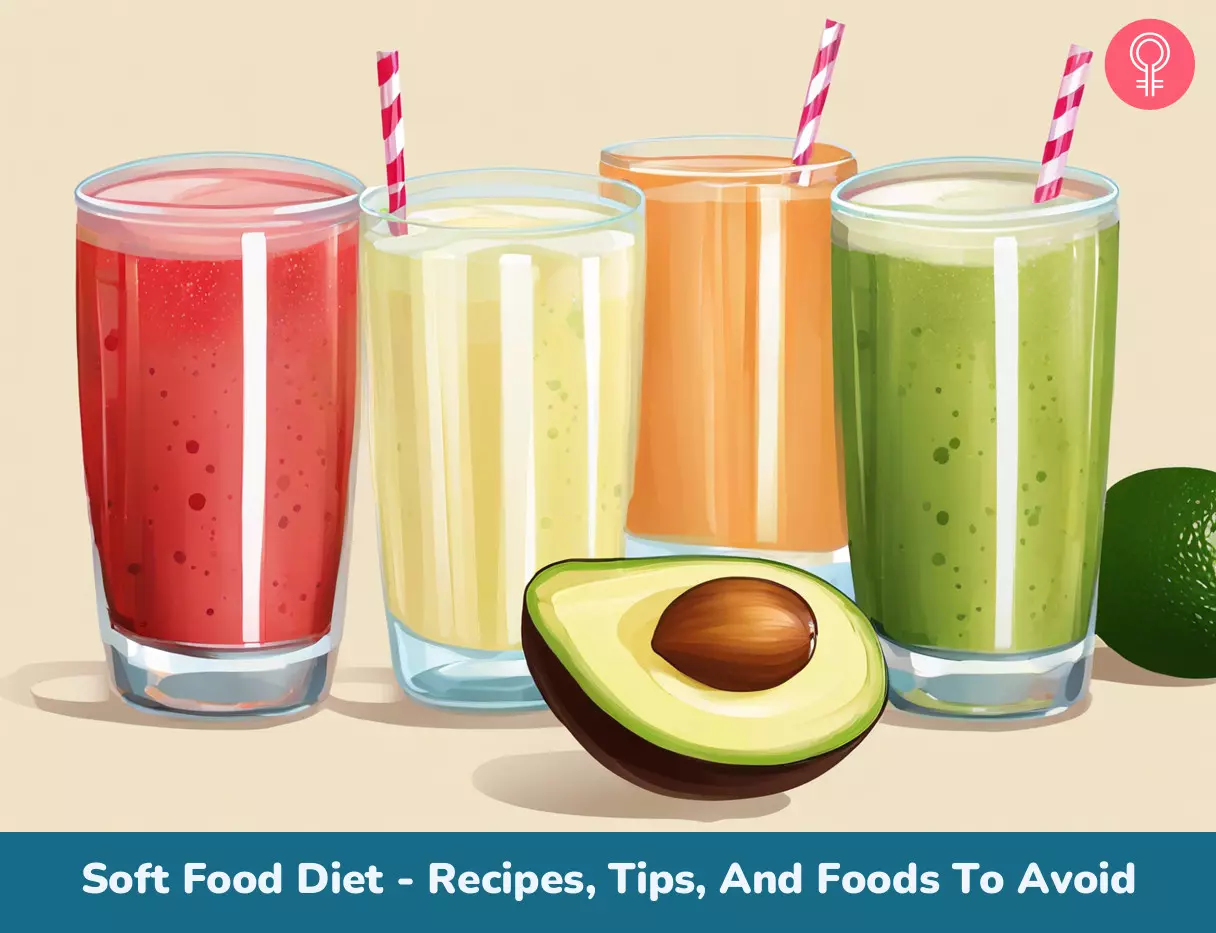Soft foods are prepared by chopping, grinding, mincing, and mashing or can even involve a liquid diet. These are low-fiber foods and mineral-rich foods that help without compromising on essential nutrients. Read on to know which foods to eat and avoid in a soft food diet, a few delicious recipes, a soft food diet chart, and tips. Scroll down!
What Is The Soft Food Diet?
The soft food diet is a short-term diet plan that gives the digestive system a bit of rest. Since the foods are generally low-fiber, soft, chopped, mashed, or blended, such that there is no need for them to be chewed, it is also known as the dysphagia diet. You may need to be on a soft food diet temporarily or permanently, depending on your medical condition. When you are on a soft food diet, you must be careful about what foods you eat. To know what you should eat and avoid, take a look at the following sections.
What To Eat On A Soft Food Diet
You must choose foods that are easy to chew, swallow, and digest. But they should also be nutrient-dense foods. Here’s a list of nutritious foods that you may include in your soft food diet (1): Veggies
Well-cooked veggies without skin or seeds Mashed potatoes Boiled and mashed veggies Vegetable juice
Fruits
Banana Avocado Strained fruit juice Applesauce Canned and peeled fruits
Protein
Poached or scrambled eggs Ground or finely chopped cooked meat and fish Canned fish Boiled and mashed lentils and beans Grated or finely chopped tofu Hummus
Grains/Cereals/Pasta
White rice, mashed Egg noodles White bread, mashed or finely chopped Well-cooked pasta Porridge oats
Dairy
Milk and milkshakes Yogurt Cottage cheese, mashed Ricotta cheese, mashed Crème fraîche Ice cream
Dessert
Jelly Gelatin Puddings Custard with ground or finely chopped fruits Very, very, moist cake Mousse
Sauces
Vegetable or chicken stock Bone broth White sauce Cheese sauce
You have a lot of food options in this diet and will not be bored with the sameness. BUT be cautious with a few foods. Here’s a list of foods you must avoid.
Foods To Avoid
Veggies
Veggies that cannot be mashed easily like broccoli, carrot, celery, and cauliflower Fried potatoes Kale or beetroot chips
Fruits
Fruits, raw or cooked with the peel Pear and apple Dry fruits Pineapple High-fiber fruits such as sapodilla Fibrous fruits such as mango Fruit with seeds, like blackberries and strawberries
Protein
Fatty and overcooked meat Fried meat or fish Processed meat like sausage, salami, and chorizo Beef jerky Hot dogs Peanut butter Seeds Cooked, whole lentils or beans
Grains/Cereals/Pasta
Corn Popcorn Bagel Sourdough bread French bread Toast Unsoftened cereals Toasts and crackers
Dairy
Ice cream and yogurt with nuts, coconut, fruits with skin or seeds, and granola
Dessert
Pie Crumble Dry cakes Peanut butter cups
Sauces
Hot sauce BBQ sauce
You must avoid foods that can potentially irritate your stomach and/or are difficult to chew and swallow. Specific health issues require the patients to be on a soft food diet. The next section will help you understand if a soft food diet is for you. Take a look.
Who Should Follow A Soft Food Diet?
Here’s when your doctor will recommend you to be on a soft food diet:
Post Surgery
If you have recently undergone head, neck, or stomach surgery, your doctor will ask you to be on a soft food diet (2). A few examples of these kinds of surgeries are bariatric surgeryi Surgical procedure in which changes are made to the digestive system to aid in weight loss in obese patients. and gastrectomyi Surgical removal of the whole or a part of the stomach, commonly done in association with cancer treatment. .
Dental Problems
Wisdom tooth extraction and loose denturesi Artificial replacement for teeth and the surrounding gums used to fill in for missing teeth or whole teeth. are very common. During this time, it is ideal to be on a pureed diet so that you do not have to make an effort to chew. The soft texture of foods will allow you to swallow the food directly. On a similar note, Larissa Conte, a blogger who underwent dental surgery, switched from a solid diet to a soft food diet post the procedure. She shared her preferences for curating a customized diet plant, “I’m prioritizing a nutrient-dense, seasonal, anti-inflammatory diet—the general guidelines for my diet anyway. I’m going mostly vegan because pasteurized dairy is generally inflammatory/mucus causing and puréed or mashed fish is joyless to me (i).” The blogger also stated that she tried including overcooked pasta and baked fish in her diet, but she felt it was hard on her stomach and didn’t enjoy having it as she just used the tongue and the roof of her mouth to chew. This will also prevent the possibility of food getting stuck and infection (3).
Difficulty Swallowing
In cases of swallowing difficulties or dysphagia, doctors recommend consuming soft foods. The soft, liquidy texture of the food will allow you to consume it without putting too much stress on the muscles that aid swallowing (4), (5).
Cancer Treatment
Radiotherapyi Disease treatment using ionizing radiation. Usually used to eliminate malignant cells in cancer treatment. and chemotherapyi The treatment of fast-growing cancer cells using powerful drugs. May be done to cure, prolong life, or reduce symptoms. mostly cause inflammation of the digestive tract (6). This condition is also known as mucositis, and patients are recommended to be on a soft diet during this time.
Best Tips For Preparing Soft Foods
Wash and peel the veggies and fruits. Cut the foods (including meat, eggs, tofu, and cottage cheese) into small pieces. Cook the veggies, meat, fish, lentils, and beans until they are soft. Puree the foods using a blender. Pass the soup veggies through a sieve. Do not keep any lumps in mashed potato, veggies, or fruits. Cook egg scramble with butter or crème fraîche. To prepare sauces, add milk, cream, and/or melted cheese. Add stock to your food to moisten it. Moisten bread with milk or soups.
Now that you know which foods you can consume and how to cook them, let me give you a few quick soft food diet recipes to try. Scroll down.
Yummy Soft Food Recipes
1. Banana Oatmeal Smoothie
1 ripe banana 3 tablespoons porridge oats 1 cup low-fat milk 1 drop of vanilla essence
2. Mashed Potato
2 large potatoes, peeled and halved 4 tablespoons crème fraîche 1 tablespoon unsalted butter 2 tablespoons cottage cheese, pureed Salt to taste
3. Blended Couscous Mushroom Chicken Soup
200 g boneless chicken cubes 1 cup pearl couscous ½ cup button mushrooms, halved 3 cups chicken stock 1 cup vegetable stock ½ cup chopped onion 2 inch ginger, grated 1 teaspoon garlic powder 3 tablespoons fresh cream 1 tablespoon unsalted butter Salt to taste
Now, the main question is, how long should you be on a soft food diet? Let’s find out!
How Long Should You Be On A Soft Food Diet?
You will be on a soft food diet as per your doctor’s recommendation. It is best to avoid eating anything solid that might aggravate the pain or inflammation. Yes, being on a soft food diet will be a tad boring, but you must design your meals in a way that there’s a sufficient gap between two meals, and the foods that you consume are tasty. If you do not like being restrictive with your food, there is another variation of this diet you can try out. Scroll down to the next section to learn more.
Mechanical Soft Food Diet
A mechanical soft diet is a specialized eating plan designed for people who have difficulty chewing and swallowing due to medical conditions or are recovering from surgery. This diet focuses on making foods easier to consume by adjusting their texture. In a mechanical soft diet, foods are often finely chopped, pureed, or minced with the use of kitchen tools like a knife, a blender, or a food processor to the point where they require very little or no chewing. Unlike the soft diet, this diet does not restrict seasonings and sauces. However, consulting a healthcare professional before starting this diet is recommended. Which two food groups are key to the GI soft diet? Since you would be depending on soft, mashed, pureed food, and on easy-to -digest foods, you must focus on including protein and carbs in your meals. Can you drink coffee while on a soft diet? Yes, you can drink coffee, tea, juices, and milk on a soft diet. Is POHA a soft food? Yes, poha is a healthy breakfast option that helps with digestion. It is simple to digest, which prevents bloating and makes you feel fuller for longer. How do you make a soft diet? All foods can be cooked until they are soft or cut into small pieces. Use a fork or potato masher to try mashing. To puree food, use a food processor or blender. To get lumps out of stews or soups, try using a sieve. When cooking food, you can add stock to moisten it and make it simpler to swallow. What soft foods can I eat for breakfast? Soft breakfast foods are scrambled eggs and sliced avocado. Try serving cream of wheat with cooked peaches and smooth cashew butter on top. Eggs, goat cheese, spinach, and butternut squash are also used to make a crustless quiche. Another fantastic choice is a yogurt parfait. What is a Level 1 soft diet? Pureed, unified, and consistent foods make up this diet. No chunks or mixed textures are acceptable. The food shouldn’t require chewing and should be easy for the tongue to move through. It should be “pudding-like.” Some soft food diet meal and snack ideas? Applesauce, bottled fruit, vegetables that are steamed or softly cooked, Bananas, stone fruits, and melons are examples of soft, skinless fruits. Baked fruits are a wonderful soft food option for diet meals and snacks. Can I still get enough protein on a soft food diet, and what are some good sources of protein? Nutrient-dense choices include soft foods high in protein, such as low-fat yogurt, eggs, beans, tuna, salmon, and eggs. These foods will give you more energy and keep your healing and regenerative cells active than carbohydrates. How long should I stay on a soft food diet, and when can I start reintroducing regular foods? Follow this diet for as long as your doctor recommends. Depending on when your hunger and bowel movements start to normalize, this could take two to three weeks. If you are having difficulty eating at home, speak with your dietitian or physician. Can I still enjoy social events or dining out while on a soft food diet? Yes! Bring food with you. Try bringing a straightforward dish to share at the gathering or, if it’s a potluck, bring a healthy dish. What are some tips for transitioning back to a regular diet after being on a soft food diet? Chew every food slowly until it resembles mashed potatoes. It will be simpler for your body to digest food if you chew it more thoroughly. Eat throughout the day, a few hours at a time. Instead of three large meals per day, you might feel more at ease eating four to six smaller meals. Are there any particular vitamins or nutrients that are difficult to obtain on a soft food diet? Smoothies, hot cereals, puddings, or yogurt can be enhanced with nut or seed butter to add healthy monounsaturated fats, extra protein, and calories. Cheese can increase a dish’s protein and calorie content. Try our cheesy cauliflower mash or spinach ricotta eggs. You won’t go without vital nutrients if you use this method.
Illustration: Soft Food Diet - Recipes Tips And Foods To Avoid
A soft food diet consists of foods that are easy to chew and swallow. Watch the informative video below to learn why it is recommended for people who face some difficulty while eating.
